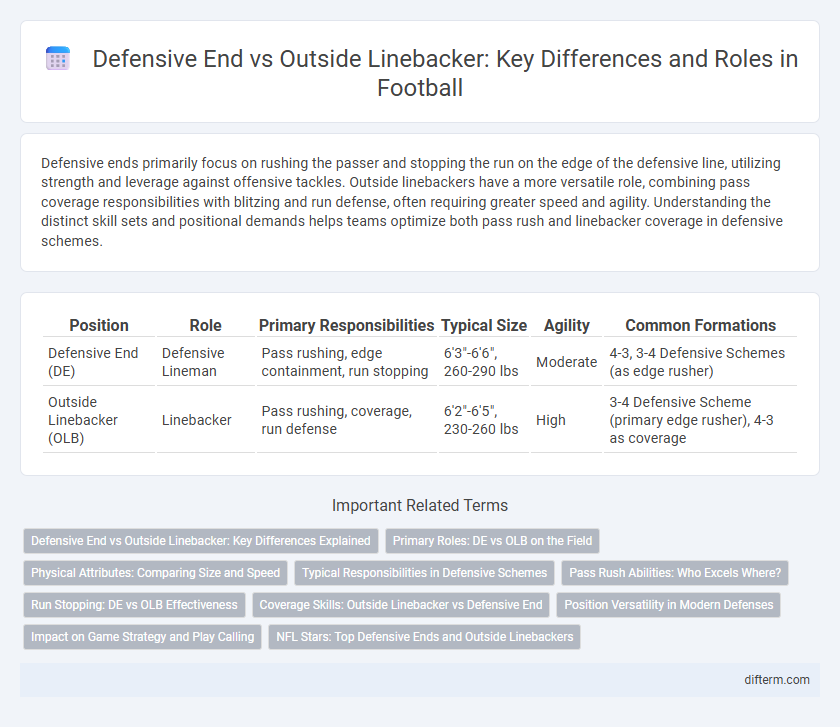Defensive ends primarily focus on rushing the passer and stopping the run on the edge of the defensive line, utilizing strength and leverage against offensive tackles. Outside linebackers have a more versatile role, combining pass coverage responsibilities with blitzing and run defense, often requiring greater speed and agility. Understanding the distinct skill sets and positional demands helps teams optimize both pass rush and linebacker coverage in defensive schemes.
Table of Comparison
| Position | Role | Primary Responsibilities | Typical Size | Agility | Common Formations |
|---|---|---|---|---|---|
| Defensive End (DE) | Defensive Lineman | Pass rushing, edge containment, run stopping | 6'3"-6'6", 260-290 lbs | Moderate | 4-3, 3-4 Defensive Schemes (as edge rusher) |
| Outside Linebacker (OLB) | Linebacker | Pass rushing, coverage, run defense | 6'2"-6'5", 230-260 lbs | High | 3-4 Defensive Scheme (primary edge rusher), 4-3 as coverage |
Defensive End vs Outside Linebacker: Key Differences Explained
Defensive ends primarily line up on the defensive line and focus on rushing the quarterback and stopping the run at the edge, using their size and strength to control offensive tackles. Outside linebackers position themselves slightly off the line of scrimmage, blending pass coverage responsibilities with quarterback pressure, relying on agility and versatility to cover tight ends and running backs. The key difference lies in their alignment and role flexibility, with defensive ends being more specialized pass rushers and outside linebackers serving as hybrid defenders adapting to both run and pass defense.
Primary Roles: DE vs OLB on the Field
Defensive ends primarily focus on rushing the passer and containing the edge against the run, using their size and strength to overpower offensive tackles. Outside linebackers have more versatile roles, blending pass coverage responsibilities with edge rushing and run support, often requiring greater speed and agility. The contrasting demands on DEs and OLBs shape their positioning and techniques, with DEs lining up on the line of scrimmage and OLBs frequently positioning themselves just off the line.
Physical Attributes: Comparing Size and Speed
Defensive ends typically possess larger frames, often weighing between 260 to 290 pounds, enabling them to anchor the defensive line against powerful offensive linemen. Outside linebackers generally prioritize speed and agility, weighing lighter at 230 to 260 pounds to effectively cover more ground and pursue quarterbacks or ball carriers. The size-speed balance defines their roles, with defensive ends excelling in power and outside linebackers in quickness and versatility.
Typical Responsibilities in Defensive Schemes
Defensive ends primarily focus on rushing the passer and setting the edge against the run, often lining up on the line of scrimmage and engaging directly with offensive tackles. Outside linebackers have more versatile responsibilities including pass coverage, containing the run, and blitzing, frequently dropping into coverage or attacking from the second level. Defensive schemes utilize defensive ends for consistent pressure up front, while outside linebackers adapt based on the formation, balancing coverage duties with pass-rush assignments.
Pass Rush Abilities: Who Excels Where?
Defensive ends typically excel in pass rush due to their size, strength, and ability to engage directly with offensive tackles, allowing them to generate powerful, consistent pressure on the quarterback. Outside linebackers, meanwhile, leverage their speed, agility, and versatility to excel in edge rushing, often using varied angles and coverage responsibilities that enhance their unpredictability in blitz schemes. The pass rush effectiveness of defensive ends centers on power and leverage, while outside linebackers thrive on speed and tactical versatility.
Run Stopping: DE vs OLB Effectiveness
Defensive ends (DEs) excel at run stopping by controlling the line of scrimmage with powerful bursts and shedding blocks to tackle ball carriers quickly in the backfield or at the line. Outside linebackers (OLBs) contribute to run defense with greater lateral speed and agility, allowing them to contain outside runs and pursue ball carriers in open space effectively. While DEs anchor the defensive front, OLBs provide versatile edge containment and pursuit, making their combined efforts essential for a robust run-stopping defense.
Coverage Skills: Outside Linebacker vs Defensive End
Outside linebackers excel in coverage skills with the agility and speed to defend against tight ends and running backs in pass routes, often dropping back into zone or man coverage. Defensive ends primarily focus on pass rushing and run stopping, possessing less versatility in pass coverage due to their larger build and positioning on the line of scrimmage. The superior coverage abilities of outside linebackers make them crucial in defending against modern passing offenses where versatile defenders are needed.
Position Versatility in Modern Defenses
Defensive ends and outside linebackers both play crucial roles in modern defensive schemes, with position versatility becoming increasingly valuable. Defensive ends primarily focus on pass rushing and edge setting, while outside linebackers often balance pass coverage, run defense, and blitzing, adapting to various offensive formations. This versatility allows defenses to disguise alignments and react dynamically, optimizing personnel usage across passing and running downs.
Impact on Game Strategy and Play Calling
Defensive ends primarily focus on pressuring the quarterback and stopping the run on the edge, forcing offenses to adjust blocking schemes and limit outside runs. Outside linebackers provide versatile coverage options and blitzing capabilities, enabling defenses to disguise their intentions and create confusion for opposing quarterbacks. Strategic play calling often leverages the speed and agility of outside linebackers to enhance pass defense while relying on the strength and power of defensive ends to control line matchups.
NFL Stars: Top Defensive Ends and Outside Linebackers
NFL stars like Myles Garrett and T.J. Watt exemplify the power and versatility of defensive ends and outside linebackers, excelling in pass rushing and run defense. Defensive ends typically anchor the defensive line, using size and strength to disrupt offensive plays, while outside linebackers combine speed and agility to cover passes and blitz quarterbacks. Elite players in these positions, such as Aaron Donald (DE) and Khalil Mack (OLB), showcase the critical role they play in creating turnovers and pressuring opposing offenses.
defensive end vs outside linebacker Infographic

 difterm.com
difterm.com